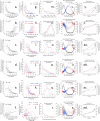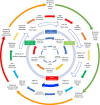Coronavirus seasonality, respiratory infections and weather
- PMID: 34702177
- PMCID: PMC8547307
- DOI: 10.1186/s12879-021-06785-2
Coronavirus seasonality, respiratory infections and weather
Abstract
Background: The survival of coronaviruses are influenced by weather conditions and seasonal coronaviruses are more common in winter months. We examine the seasonality of respiratory infections in England and Wales and the associations between weather parameters and seasonal coronavirus cases.
Methods: Respiratory virus disease data for England and Wales between 1989 and 2019 was extracted from the Second-Generation Surveillance System (SGSS) database used for routine surveillance. Seasonal coronaviruses from 2012 to 2019 were compared to daily average weather parameters for the period before the patient's specimen date with a range of lag periods.
Results: The seasonal distribution of 985,524 viral infections in England and Wales (1989-2019) showed coronavirus infections had a similar seasonal distribution to influenza A and bocavirus, with a winter peak between weeks 2 to 8. Ninety percent of infections occurred where the daily mean ambient temperatures were below 10 °C; where daily average global radiation exceeded 500 kJ/m2/h; where sunshine was less than 5 h per day; or where relative humidity was above 80%. Coronavirus infections were significantly more common where daily average global radiation was under 300 kJ/m2/h (OR 4.3; CI 3.9-4.6; p < 0.001); where average relative humidity was over 84% (OR 1.9; CI 3.9-4.6; p < 0.001); where average air temperature was below 10 °C (OR 6.7; CI 6.1-7.3; p < 0.001) or where sunshine was below 4 h (OR 2.4; CI 2.2-2.6; p < 0.001) when compared to the distribution of weather values for the same time period. Seasonal coronavirus infections in children under 3 years old were more frequent at the start of an annual epidemic than at the end, suggesting that the size of the susceptible child population may be important in the annual cycle.
Conclusions: The dynamics of seasonal coronaviruses reflect immunological, weather, social and travel drivers of infection. Evidence from studies on different coronaviruses suggest that low temperature and low radiation/sunlight favour survival. This implies a seasonal increase in SARS-CoV-2 may occur in the UK and countries with a similar climate as a result of an increase in the R0 associated with reduced temperatures and solar radiation. Increased measures to reduce transmission will need to be introduced in winter months for COVID-19.
Keywords: COVID-19; Children; Climate; Coronavirus; Pandemic; Respiratory viruses; Seasonality; Surveillance; Virus survival; Weather.
© 2021. The Author(s).
Conflict of interest statement
All authors have indicated that they have no competing interests other than the funding from the National Institute for Health Research.
Figures




References
MeSH terms
Grants and funding
LinkOut - more resources
Full Text Sources
Medical
Miscellaneous

